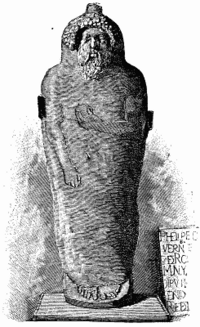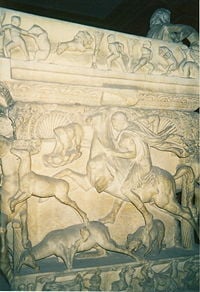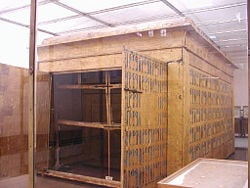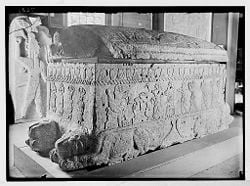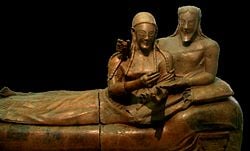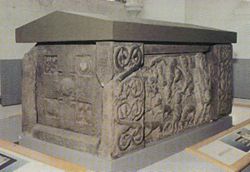Difference between revisions of "Sarcophagus" - New World Encyclopedia
Rosie Tanabe (talk | contribs) |
Rosie Tanabe (talk | contribs) |
||
| (4 intermediate revisions by 3 users not shown) | |||
| Line 1: | Line 1: | ||
| − | {{ | + | {{Images OK}}{{Submitted}}{{Approved}}{{Paid}}{{copyedited}} |
[[Category:Politics and social sciences]] | [[Category:Politics and social sciences]] | ||
[[Category:Anthropology]] | [[Category:Anthropology]] | ||
[[Category:Archaeology]] | [[Category:Archaeology]] | ||
[[Image:Anthropoid sarcophagus discovered at Cadiz - Project Gutenberg eText 15052.png|200px|thumb|right|Anthropoid sarcophagus discovered at [[Cádiz]]]] | [[Image:Anthropoid sarcophagus discovered at Cadiz - Project Gutenberg eText 15052.png|200px|thumb|right|Anthropoid sarcophagus discovered at [[Cádiz]]]] | ||
| − | A '''sarcophagus''' (plural:'''sarcophagi''') is an above ground stone container for a [[coffin]] or [[death|dead]] body | + | A '''sarcophagus''' (plural:'''sarcophagi''') is an above ground stone container for a [[coffin]] or [[death|dead]] body that often is decorated with [[art]], inscriptions, and [[carving]]s. First used in [[Ancient Egypt]] and [[Ancient Greece]], the sarcophagus gradually became popular throughout the ancient world. It carried over through the later years of [[Europe|European]] society, often used for high status members of the [[clergy]], [[government]], or [[aristocracy]]. |
| − | Made of stone, these sarcophagi have endured through the centuries and provide valuable information for [[archaeology|archaeologists]] regarding the lives of those who lived in ancient times. Often decorated with artwork on the outside, they display the [[creativity|creative]] talents and ideas of the times as well as providing significant information regarding the lives and times of the deceased whose remains they contain. Such cultures revered their dead, often preserving their [[mummy|mummified]] body within the sarcophagus as well as | + | Made of stone, these sarcophagi have endured through the centuries and provide valuable information for [[archaeology|archaeologists]] regarding the lives of those who lived in ancient times. Often decorated with artwork on the outside, they display the [[creativity|creative]] talents and ideas of the times as well as providing significant information regarding the lives and times of the deceased whose remains they contain. Such cultures revered their dead, often preserving their [[mummy|mummified]] body within the sarcophagus as well as including items of value for them in the [[afterlife]]. The external decorations often recorded the deceased’s achievements. Thus, sarcophagi are one of the significant items that reveal information about the lives of those long past, lives that often continue to impact human society even today. |
==Etymology== | ==Etymology== | ||
| − | The word '''sarcophagus''' comes from the [[Greek language|Greek]] "sarx" meaning "flesh," and "phagien" meaning "to eat," so that ''sarcophagus'' | + | |
| + | The word '''sarcophagus''' comes from the [[Greek language|Greek]] "sarx" meaning "flesh," and "phagien" meaning "to eat," so that ''sarcophagus,'' literally translates as "eater of flesh." The fifth century B.C.E. [[Ancient Greece|Greek]] historian, [[Herodotus]], noted that early sarcophagi were carved from a special kind of rock that consumed the flesh of the [[corpse]] inside. In particular, coffins made of a [[limestone]] from [[Assus]] in the [[Troad]] known as ''lapis Assius'' had the property of consuming the bodies placed within them, and therefore was also called ''sarkophagos lithos'' (flesh-eating stone). All coffins made of limestone have this property to a greater or lesser degree, and the name eventually came to be applied to stone coffins in general.<ref> The American Heritage® Dictionary of the English Language, [http://dictionary.reference.com/browse/sarcophagus sarcophagus.] Retrieved October 5, 2007. </ref> | ||
[[Image:Detail sarcophagus Istanbul Arkeoloji Muzesi.jpg|left|200px|thumb|Detail of a stone sarcophagus in the [[Istanbul Archaeology Museum]] showing a hunting scene.]] | [[Image:Detail sarcophagus Istanbul Arkeoloji Muzesi.jpg|left|200px|thumb|Detail of a stone sarcophagus in the [[Istanbul Archaeology Museum]] showing a hunting scene.]] | ||
==Description== | ==Description== | ||
| − | |||
| − | The earliest were usually simple box shapes that could be inscribed upon. This was common in [[ancient Egypt]], | + | Sarcophagi differ in detail from one culture to another. They are almost always made of stone, [[limestone]] being the most popular, but sometimes of [[granite]], [[sandstone]], or [[marble]]. Sarcophagi were usually made by being carved, decorated, or constructed ornately. Some were built to be freestanding above ground, as a part of an elaborate [[tomb]] or tombs. Others were made for [[burial]], or were placed in [[crypt]]s. |
| + | |||
| + | The earliest were usually simple box shapes that could be inscribed upon. This was common in [[ancient Egypt]], where a sarcophagus was usually the external layer of protection for a [[royal]] [[mummy]], with several layers of [[coffin]]s nested within that also served to protect dead bodies. Over time, the artistry on these boxes became more detailed to include inset [[sculpture]]s, seen frequently in [[Ancient Rome|Roman]], and later, [[Catholic]] sarcophagi. The sculptures would often depict a scene from [[mythology]], or in the case of Catholicism, scenes from the [[Bible]]. Some sarcophagi actually began to take on contours similar to the human body, and often were given a painted or sculpted face. | ||
==Examples== | ==Examples== | ||
| + | |||
Following are a few examples of notable sarcophagi from around the world. | Following are a few examples of notable sarcophagi from around the world. | ||
| − | === | + | ===Tutankhamun=== |
| − | [[Image:GD-EG-Caire-Musée127.JPG|thumb|250 px|right|Funerary chapel found in Tutankhamun's tomb in the Valley of the Kings (KV62). This was the outermost of the four chapels | + | |
| − | Perhaps the most recognizable of all [[Ancient Egypt]]'s pharaohs, [[ | + | [[Image:GD-EG-Caire-Musée127.JPG|thumb|250 px|right|Funerary chapel found in Tutankhamun's tomb in the Valley of the Kings (KV62). This was the outermost of the four chapels; the innermost one contained the pharaoh's sarcophagus.]] |
| + | Perhaps the most recognizable of all [[Ancient Egypt]]'s pharaohs, [[Tutankhamun]]'s sarcophagus has proven to be just as famous as the boy whose remains inhabited it. Discovered in 1923 by [[Howard Carter]], the large sarcophagus held within it several wooden [[coffin]]s, that were inlaid one inside the other, the innermost one containing the [[mummy|mummified]] body of the boy king. The sarcophagus was of the old Egyptian simple style, a large box structure, which contained a more elaborately decorated, and more fragile, set of wooden coffins. Thus the sarcophagus was used primarily to protect the wood coffins and mummified body from the elements. | ||
===Ahiram=== | ===Ahiram=== | ||
| + | |||
[[Image:Ahiram sarcophag from Biblos XIII-XBC.jpg|thumb|250px|right|Sarcophagus of Ahiram, King of Biblos (Phoenicia) in XIII-X c. BC. Kept in Beirut National Museum]] | [[Image:Ahiram sarcophag from Biblos XIII-XBC.jpg|thumb|250px|right|Sarcophagus of Ahiram, King of Biblos (Phoenicia) in XIII-X c. BC. Kept in Beirut National Museum]] | ||
| − | One of the ancient kings of [[Phoenicia]], [[Ahiram]] ('''King of Biblos''' as he was known then) was sealed in a Late Bronze Age sarcophagus during the early tenth century B.C.E.<ref>''The Cambridge Ancient History'' | + | One of the ancient kings of [[Phoenicia]], [[Ahiram]] ('''King of Biblos''' as he was known then) was sealed in a Late Bronze Age sarcophagus during the early tenth century B.C.E.<ref> Eiddon, Iorwerth, et al. (ed.), ''The Cambridge Ancient History,'' 2nd ed. Vol. II pt.2, (Cambridge University Press, 1975), ISBN 0521086914 </ref> Upon discovery, the sarcophagus was subsequently moved to the [[Beirut National Museum]], where it is on display. To [[archaeology|archaeologists]], the sarcophagus represents a rare discovery in early Phoenician art and writing. It is also a classic example of the blending of styles, in which the box style sarcophagus is used, but intricate artwork is added around the sides. |
| − | The engraved text, apparently the oldest inscription in the [[Phoenician alphabet]] says: | + | The engraved text, apparently the oldest inscription in the [[Phoenician alphabet]] says: |
| − | <blockquote>Coffin which Itthobaal son of Ahiram, king of Byblos, made for Ahiram his father, when he placed him for eternity. Now, if a king among kings, or a governor among governors or a commander of an army should come up against Byblos and uncover this coffin, may the sceptre of his rule be torn away, may the throne of his kingdom be overturned and may peace flee from Byblos. And as for him, may his inscription be effaced.<ref> Beruit National Museum [http://www.beirutnationalmuseum.com/e-collection-bronze.htm | + | |
| + | <blockquote>Coffin which Itthobaal son of Ahiram, king of Byblos, made for Ahiram his father, when he placed him for eternity. Now, if a king among kings, or a governor among governors or a commander of an army should come up against Byblos and uncover this coffin, may the sceptre of his rule be torn away, may the throne of his kingdom be overturned and may peace flee from Byblos. And as for him, may his inscription be effaced.<ref> Beruit National Museum, [http://www.beirutnationalmuseum.com/e-collection-bronze.htm The Bronze Age.] Retrieved October 5, 2007. </ref></blockquote> | ||
===Sarcophagus of the Spouses=== | ===Sarcophagus of the Spouses=== | ||
| − | |||
| − | |||
| − | The smiling faces with their almond shaped eyes and long braided hair, as well as the shape of the feet of the bed, reveal Greek influence. The marked contrast between the high relief busts and the very flattened legs is typically Etruscan. The Etruscan artist's interest focused on the upper half of the figures, especially on the vibrant faces and gesticulating arms. It portrays the affection of a man and a woman, an image never before seen in the Greek culture.<ref> Yona | + | [[Image:Banditaccia Sarcofago Degli Sposi.jpg|thumb|250px|The [[Etruscan]] ''[[Sarcophagus of the Spouses]]'' at the [[National Etruscan Museum]]]] |
| + | The '''Sarcophagus of the Spouses''' (Italian: ''Sarcofago degli Sposi'') is a late sixth century B.C.E. [[Etruscan art|Etruscan]] [[anthropoid]] sarcophagus. It is 3.7 feet (1.14 meters) high by 6.2 feet (1.9 meters) wide, and is made of painted [[terracotta]]. It depicts a married couple reclining at a banquet together in the [[afterlife]] (in a scene similar to that from contemporary Greek vases) and was found in nineteenth century excavations at the [[necropolis]] of [[Cerveteri]] (ancient [[Caere]]). It is now in the [[National Etruscan Museum]] of [[Villa Giulia]], [[Rome]]. | ||
| + | |||
| + | The smiling faces with their almond shaped eyes and long braided hair, as well as the shape of the feet of the bed, reveal Greek influence. The marked contrast between the high relief busts and the very flattened legs is typically Etruscan. The Etruscan artist's interest focused on the upper half of the figures, especially on the vibrant faces and gesticulating arms. It portrays the affection of a man and a woman, an image never before seen in the Greek culture.<ref> Williams, Yona, Ancient Etruscan Art.</ref> | ||
===Sarcofago di Stilicone=== | ===Sarcofago di Stilicone=== | ||
| + | |||
[[Image:9822 - Milano - Sant'Ambrogio - Sarcofago di Stilicone - Foto Giovanni Dall'Orto 25-Apr-2007.jpg|thumb|200px|left|"Sarcofago di Stilicone" ("Stilicho's sarcophagus")]] | [[Image:9822 - Milano - Sant'Ambrogio - Sarcofago di Stilicone - Foto Giovanni Dall'Orto 25-Apr-2007.jpg|thumb|200px|left|"Sarcofago di Stilicone" ("Stilicho's sarcophagus")]] | ||
| − | The so-called '''Sarcofago di Stilicone''' ("Stilicho's sarcophagus") is an Ancient Roman paleochristian sarcophagus dating from around 385 C.E., sculpted for a high- | + | The so-called '''Sarcofago di Stilicone''' ("Stilicho's sarcophagus") is an Ancient Roman paleochristian sarcophagus dating from around 385 C.E., sculpted for a high-ranking military authority and his wife. It is preserved beneath the pulpit of Saint Ambrose Basilica in [[Milan]], [[Italy]], in the same spot where it was originally placed, which makes it the only part of the original paleochristian basilica still in place. |
===St. Andrew=== | ===St. Andrew=== | ||
| − | |||
| − | |||
| − | + | [[Image:Standrewssarcophagus.jpg|thumb|right|250px|St. Andrew's Sarcophagus.]] | |
| + | '''Saint Andrew's Sarcophagus''' is a [[Picts|Pictish]] monument dating from the middle of the eighth century. The sarcophagus was recovered beginning in 1833 during excavations by [[St Andrew's Cathedral, St Andrews|St. Andrew's Cathedral]], but it was not until 1922 that the surviving components were reunited. The sarcophagus is currently on display at the Cathedral museum in [[St. Andrews]], close to the site of its discovery. | ||
| − | The surviving side panel shows, from right to left, a figure breaking the jaws of a [[lion]], a mounted hunter with his sword raised to strike a leaping lion, and hunter on foot, armed with a spear and assisted by a hunting dog, about to attack a [[wolf]]. Although it is not certain that the first two figures represent the same person, nineteenth century illustrations depict them as if they are. The surviving end panel is much simpler, essentially a cross with four small panels between the arms. The fragments of the missing end panel are similar, but not identical, to the surviving one.<ref | + | As originally constructed, the sarcophagus would have comprised of two side panels, two end panels, four corner pieces, and a roof slab. The roof slab is entirely missing, as are most of one side and one end panel and a corner piece so that the extant sarcophagus is essentially L-shaped. The external dimensions of the sarcophagus are 5.8 feet by 2.9 feet with a height of 2.3 feet. The stone used is a local [[sandstone]].<ref> Foster, Sally M. (Ed.), ''The St Andrews Sarcophagus: A Pictish Masterpiece and Its International Connection,'' (Four Courts Press, 1998), ISBN 1851824154 </ref> |
| + | |||
| + | The surviving side panel shows, from right to left, a figure breaking the jaws of a [[lion]], a mounted hunter with his sword raised to strike a leaping lion, and hunter on foot, armed with a spear and assisted by a hunting dog, about to attack a [[wolf]]. Although it is not certain that the first two figures represent the same person, nineteenth century illustrations depict them as if they are. The surviving end panel is much simpler, essentially a cross with four small panels between the arms. The fragments of the missing end panel are similar, but not identical, to the surviving one.<ref> Foster, Sally M. (Ed.), ''The St Andrews Sarcophagus: A Pictish Masterpiece and Its International Connection,'' (Four Courts Press, 1998), ISBN 1851824154 </ref> | ||
==Gallery== | ==Gallery== | ||
| + | |||
<Gallery> | <Gallery> | ||
| − | Image:Sarcophagus Ariadne Louvre Ma1346.jpg|Ariadne and Dionysus. Front panel of a marble sarcophagus, early third century | + | Image:Sarcophagus Ariadne Louvre Ma1346.jpg|Ariadne and Dionysus. Front panel of a marble sarcophagus, early third century C.E. Found in 1804 at Saint-Médard d'Eyrans, France. |
| − | Image:Egypte louvre 004.jpg|Mummy cartonnage bearing the name of | + | Image:Egypte louvre 004.jpg|Mummy cartonnage bearing the name of Dame Tacheretpaankh. Glued, stuccoed, and gilded layers of canvas, third to first centuries B.C.E. |
| − | Image:Nuremberg L.A.Feuerbach Sarcophagus f ne.jpg|Nuremberg, Ludwig Andreas Feuerbach, Sarcophagus, from | + | Image:Nuremberg L.A.Feuerbach Sarcophagus f ne.jpg|Nuremberg, Ludwig Andreas Feuerbach, Sarcophagus, from the northeast. |
| − | Image:Leopold Precan - sarcophagus.jpg|Sarcophagus of | + | Image:Leopold Precan - sarcophagus.jpg|Sarcophagus of Archbishop of Olomouc Leopold Prečan in the crypt in Sts. Cyril and Methodius's church in Olomouc (Czech Republic). |
| − | Image:Sarcophage cathédrale Laon.JPG|Top of a sarcophagi in Laon's cathedral, Aisne, France | + | Image:Sarcophage cathédrale Laon.JPG|Top of a sarcophagi in Laon's cathedral, Aisne, France. |
| − | Image:Sarkophag.JPG|The grave of the famous | + | Image:Sarkophag.JPG|The grave of the famous Major Franz Adickes of Frankfurt, Germany. |
| − | Image:Etruscan sarcophagus SMS n2.jpg|Lid of an Etruscan sarcophagus. Museum Santa Maria della Scala, Siena | + | Image:Etruscan sarcophagus SMS n2.jpg|Lid of an Etruscan sarcophagus. Museum Santa Maria della Scala, Siena. |
Image:SMinTrast.jpg|Sarcophagus (Third Century), portico of Santa Maria in Trastevere, Roma. | Image:SMinTrast.jpg|Sarcophagus (Third Century), portico of Santa Maria in Trastevere, Roma. | ||
| − | Image:DSC00526 - Cattedrale - Tomba di Costanza d'Altavilla + 1198 - Foto G. Dall'Orto.jpg|Porphyry Sarcophagus of | + | Image:DSC00526 - Cattedrale - Tomba di Costanza d'Altavilla + 1198 - Foto G. Dall'Orto.jpg|Porphyry Sarcophagus of Emperor Constance of Sicily (1154-1198), in the Cathedral of Palermo (Sicily). Picture by Giovanni Dall'Orto. |
| − | Image:Tomb of Marcellus II.jpg|Tomb of Marcellus II, "grotte vaticane," Basilica di San Pietro | + | Image:Tomb of Marcellus II.jpg|Tomb of Marcellus II, "grotte vaticane," Basilica di San Pietro. |
| − | Image:Istanbul - Museo archeol. - Sarcofago delle piangenti - ca. 350 a.C. - Foto G. Dall'Orto 28-5-2006 01.jpg|Istanbul Archaeological Museum. The so called "Sarcophagus of the | + | Image:Istanbul - Museo archeol. - Sarcofago delle piangenti - ca. 350 a.C. - Foto G. Dall'Orto 28-5-2006 01.jpg|Istanbul Archaeological Museum. The so called "Sarcophagus of the Mourning Women." From the Royal necropolis of Sidon, fourth century B.C.E. |
| − | Image:Sarcophagus Maconiana Severiana Getty Villa 83.AA.275.jpg|Weddings of Dionysos and Ariadne. The Latin inscription identifies the girl for whom this sarcophagus was made as Maconiana Severiana, member of a wealthy senatorial family. Ariadne's face was probably left unfinished to be completed as a portrait of Maconiana | + | Image:Sarcophagus Maconiana Severiana Getty Villa 83.AA.275.jpg|Weddings of Dionysos and Ariadne. The Latin inscription identifies the girl for whom this sarcophagus was made as Maconiana Severiana, a member of a wealthy senatorial family. Ariadne's face was probably left unfinished to be completed as a portrait of Maconiana. |
</Gallery> | </Gallery> | ||
| − | == | + | ==Notes== |
| + | |||
<References/> | <References/> | ||
==References== | ==References== | ||
| − | *Budge, E.A. Wallis | + | *Budge, E.A. Wallis. ''The Sarcophagus of Anchnesraneferab Queen of Ahmes II King of Egypt.'' Kessinger Publishing. 2004. ISBN 1417947608 |
| − | *Foster, Sally M | + | *Foster, Sally M. ''The St. Andrews Sarcophagus: A Pictish Masterpiece and Its International Connection.'' Four Courts Press. 1998. ISBN 1851824154 |
| − | *Grajetzki, Wolfram | + | *Grajetzki, Wolfram. ''Burial Customs in Ancient Egypt: Life in Death for Rich and Poor.'' Duckworth Publishers. 2003. ISBN 0715632175 |
{{Credit1|Sarcophagus|99489906|}} | {{Credit1|Sarcophagus|99489906|}} | ||
Latest revision as of 02:26, 21 April 2023
A sarcophagus (plural:sarcophagi) is an above ground stone container for a coffin or dead body that often is decorated with art, inscriptions, and carvings. First used in Ancient Egypt and Ancient Greece, the sarcophagus gradually became popular throughout the ancient world. It carried over through the later years of European society, often used for high status members of the clergy, government, or aristocracy.
Made of stone, these sarcophagi have endured through the centuries and provide valuable information for archaeologists regarding the lives of those who lived in ancient times. Often decorated with artwork on the outside, they display the creative talents and ideas of the times as well as providing significant information regarding the lives and times of the deceased whose remains they contain. Such cultures revered their dead, often preserving their mummified body within the sarcophagus as well as including items of value for them in the afterlife. The external decorations often recorded the deceased’s achievements. Thus, sarcophagi are one of the significant items that reveal information about the lives of those long past, lives that often continue to impact human society even today.
Etymology
The word sarcophagus comes from the Greek "sarx" meaning "flesh," and "phagien" meaning "to eat," so that sarcophagus, literally translates as "eater of flesh." The fifth century B.C.E. Greek historian, Herodotus, noted that early sarcophagi were carved from a special kind of rock that consumed the flesh of the corpse inside. In particular, coffins made of a limestone from Assus in the Troad known as lapis Assius had the property of consuming the bodies placed within them, and therefore was also called sarkophagos lithos (flesh-eating stone). All coffins made of limestone have this property to a greater or lesser degree, and the name eventually came to be applied to stone coffins in general.[1]
Description
Sarcophagi differ in detail from one culture to another. They are almost always made of stone, limestone being the most popular, but sometimes of granite, sandstone, or marble. Sarcophagi were usually made by being carved, decorated, or constructed ornately. Some were built to be freestanding above ground, as a part of an elaborate tomb or tombs. Others were made for burial, or were placed in crypts.
The earliest were usually simple box shapes that could be inscribed upon. This was common in ancient Egypt, where a sarcophagus was usually the external layer of protection for a royal mummy, with several layers of coffins nested within that also served to protect dead bodies. Over time, the artistry on these boxes became more detailed to include inset sculptures, seen frequently in Roman, and later, Catholic sarcophagi. The sculptures would often depict a scene from mythology, or in the case of Catholicism, scenes from the Bible. Some sarcophagi actually began to take on contours similar to the human body, and often were given a painted or sculpted face.
Examples
Following are a few examples of notable sarcophagi from around the world.
Tutankhamun
Perhaps the most recognizable of all Ancient Egypt's pharaohs, Tutankhamun's sarcophagus has proven to be just as famous as the boy whose remains inhabited it. Discovered in 1923 by Howard Carter, the large sarcophagus held within it several wooden coffins, that were inlaid one inside the other, the innermost one containing the mummified body of the boy king. The sarcophagus was of the old Egyptian simple style, a large box structure, which contained a more elaborately decorated, and more fragile, set of wooden coffins. Thus the sarcophagus was used primarily to protect the wood coffins and mummified body from the elements.
Ahiram
One of the ancient kings of Phoenicia, Ahiram (King of Biblos as he was known then) was sealed in a Late Bronze Age sarcophagus during the early tenth century B.C.E.[2] Upon discovery, the sarcophagus was subsequently moved to the Beirut National Museum, where it is on display. To archaeologists, the sarcophagus represents a rare discovery in early Phoenician art and writing. It is also a classic example of the blending of styles, in which the box style sarcophagus is used, but intricate artwork is added around the sides.
The engraved text, apparently the oldest inscription in the Phoenician alphabet says:
Coffin which Itthobaal son of Ahiram, king of Byblos, made for Ahiram his father, when he placed him for eternity. Now, if a king among kings, or a governor among governors or a commander of an army should come up against Byblos and uncover this coffin, may the sceptre of his rule be torn away, may the throne of his kingdom be overturned and may peace flee from Byblos. And as for him, may his inscription be effaced.[3]
Sarcophagus of the Spouses
The Sarcophagus of the Spouses (Italian: Sarcofago degli Sposi) is a late sixth century B.C.E. Etruscan anthropoid sarcophagus. It is 3.7 feet (1.14 meters) high by 6.2 feet (1.9 meters) wide, and is made of painted terracotta. It depicts a married couple reclining at a banquet together in the afterlife (in a scene similar to that from contemporary Greek vases) and was found in nineteenth century excavations at the necropolis of Cerveteri (ancient Caere). It is now in the National Etruscan Museum of Villa Giulia, Rome.
The smiling faces with their almond shaped eyes and long braided hair, as well as the shape of the feet of the bed, reveal Greek influence. The marked contrast between the high relief busts and the very flattened legs is typically Etruscan. The Etruscan artist's interest focused on the upper half of the figures, especially on the vibrant faces and gesticulating arms. It portrays the affection of a man and a woman, an image never before seen in the Greek culture.[4]
Sarcofago di Stilicone
The so-called Sarcofago di Stilicone ("Stilicho's sarcophagus") is an Ancient Roman paleochristian sarcophagus dating from around 385 C.E., sculpted for a high-ranking military authority and his wife. It is preserved beneath the pulpit of Saint Ambrose Basilica in Milan, Italy, in the same spot where it was originally placed, which makes it the only part of the original paleochristian basilica still in place.
St. Andrew
Saint Andrew's Sarcophagus is a Pictish monument dating from the middle of the eighth century. The sarcophagus was recovered beginning in 1833 during excavations by St. Andrew's Cathedral, but it was not until 1922 that the surviving components were reunited. The sarcophagus is currently on display at the Cathedral museum in St. Andrews, close to the site of its discovery.
As originally constructed, the sarcophagus would have comprised of two side panels, two end panels, four corner pieces, and a roof slab. The roof slab is entirely missing, as are most of one side and one end panel and a corner piece so that the extant sarcophagus is essentially L-shaped. The external dimensions of the sarcophagus are 5.8 feet by 2.9 feet with a height of 2.3 feet. The stone used is a local sandstone.[5]
The surviving side panel shows, from right to left, a figure breaking the jaws of a lion, a mounted hunter with his sword raised to strike a leaping lion, and hunter on foot, armed with a spear and assisted by a hunting dog, about to attack a wolf. Although it is not certain that the first two figures represent the same person, nineteenth century illustrations depict them as if they are. The surviving end panel is much simpler, essentially a cross with four small panels between the arms. The fragments of the missing end panel are similar, but not identical, to the surviving one.[6]
Gallery
Notes
- ↑ The American Heritage® Dictionary of the English Language, sarcophagus. Retrieved October 5, 2007.
- ↑ Eiddon, Iorwerth, et al. (ed.), The Cambridge Ancient History, 2nd ed. Vol. II pt.2, (Cambridge University Press, 1975), ISBN 0521086914
- ↑ Beruit National Museum, The Bronze Age. Retrieved October 5, 2007.
- ↑ Williams, Yona, Ancient Etruscan Art.
- ↑ Foster, Sally M. (Ed.), The St Andrews Sarcophagus: A Pictish Masterpiece and Its International Connection, (Four Courts Press, 1998), ISBN 1851824154
- ↑ Foster, Sally M. (Ed.), The St Andrews Sarcophagus: A Pictish Masterpiece and Its International Connection, (Four Courts Press, 1998), ISBN 1851824154
ReferencesISBN links support NWE through referral fees
- Budge, E.A. Wallis. The Sarcophagus of Anchnesraneferab Queen of Ahmes II King of Egypt. Kessinger Publishing. 2004. ISBN 1417947608
- Foster, Sally M. The St. Andrews Sarcophagus: A Pictish Masterpiece and Its International Connection. Four Courts Press. 1998. ISBN 1851824154
- Grajetzki, Wolfram. Burial Customs in Ancient Egypt: Life in Death for Rich and Poor. Duckworth Publishers. 2003. ISBN 0715632175
Credits
New World Encyclopedia writers and editors rewrote and completed the Wikipedia article in accordance with New World Encyclopedia standards. This article abides by terms of the Creative Commons CC-by-sa 3.0 License (CC-by-sa), which may be used and disseminated with proper attribution. Credit is due under the terms of this license that can reference both the New World Encyclopedia contributors and the selfless volunteer contributors of the Wikimedia Foundation. To cite this article click here for a list of acceptable citing formats.The history of earlier contributions by wikipedians is accessible to researchers here:
The history of this article since it was imported to New World Encyclopedia:
Note: Some restrictions may apply to use of individual images which are separately licensed.
